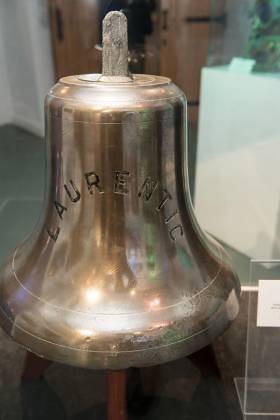Displaying items by tag: SS Laurentic
White Star Line's S.S. Laurentic Bell Makes Homecoming Voyage to Derry
#HistoricBoats - The bell of S.S. Laurentic, one of the most significant artefacts in local maritime history, will make its return to the Derry this week, following purchase at auction by Derry City and Strabane District Council.
The Bell, which was desperately rung by crew as the immense former White Star liner sank in the Lough Swilly, Co. Donegal over a century ago, will go on display at the Guildhall from today, Friday 12 January, before it finds a permanent home as Afloat previously reported in a planned Maritime Museum due to open in 2020 at Ebrington Square.
Curator with Council’s Museums and Visitor Services, Roisin Doherty said she looked forward to seeing the Bell making its return. “We are delighted to display the Laurentic bell once again, particularly in the Guildhall, where the survivors of the wreck were treated to a meal by the Mayor of the city in 1917. The tragic story of the sinking of the vessel is inextricably linked with the city and this is a fantastic way to ensure the legacy of the ship survives in memory.”
The display will be accompanied by an exhibition entitled ‘Letters from The Laurentic’, which chronicles the story of the Laurentic disaster through deeply personal correspondence, through letters, postcards and photographs of the men lost and those, fewer in number, who survived. A short documentary, ‘Wine Dark Sea; Letters from The Laurentic’, will also feature.
The exhibition was commissioned by the Ulster Canada Initiative and produced by Harry Kerr, Martha McCulloch, Jim Doherty and Don McNeill.
The Laurentic Bell is made from bell alloy and is from the Bridge area of the ship. It was found in 1979 by local diver Ray Cossum and his son Des with Allerton Salvage. It weighs 37kg and is 2ft high by 2ft wide at the base. It is one of only two bells from the ship, the other being the bow bell, which is permanently located in the belfry of the Church of Ireland at Portsalon, after being donated by the leader of the original Royal Navy salvage expedition in 1924.
In addition to being a highly important historic artefact recovered from the wreck, the bell is also significant because of a series of dents on its rim. These dents were created by a sailor on the bridge, who on the orders of the captain, beat the bell with a wrench to sound the alarm to abandon ship. The survivors of the wreck were afterwards acknowledged by the then Mayor of Londonderry, Alderman R.N. Anderson, and were beneficiaries of a large scale city-wide relief effort and treated to a meal in the Guildhall.
As referred above the bell exhibition will be on display in the Guildhall from today and continue to Wednesday, 24 January.
Mysteries of the S.S. Laurentic Revealed in Workshop
#Laurentic - History lovers on Thursday 6 April will get a closer view of some of the fascinating artefacts recovered from the tragic sinking of SS Laurentic in Lough Swilly as part of a unique workshop. The artefacts from the liner are to be held in the Tower Museum, Derry.
The workshop will give participants the chance to view a range of items recovered from the wreck site, some of which will be unveiled to the public for the first time.
Mayor of Derry City and Strabane, Alderman Hilary McClintock, said the workshops offered a unique experience for anyone who is interested in maritime history.
“In recent months following the Centenary of the sinking of the Laurentic we have become more aware of this significant chapter in our local story. There is currently a treasure trove of artefacts on display at the museum, and this is an exciting chance for anyone who wants to explore the story further to learn more about the archive.
“It’s fantastic that so many local people have contributed objects to the exhibition, which will reveal more about those who served on board on that fateful day, as well as the beautiful vessel itself.”
The event is part of the wider programme of activities surrounding the Laurentic exhibition, which is now in its third month at the museum and running until the end of June.
Education Officer with the Tower Museum, Ronan McConnell, said that participants will also have the opportunity to hear some of the unique stories behind the objects and their recovery.
“We are delighted to be unveiling a whole series of new objects not seen before which have been loaned to us recently, including some mystery objects which we are still trying to identify,” he revealed.
“We are very excited about sharing these objects with the public in the hope that they can help us to identify them. The generosity of local divers and history enthusiasts - including relatives of those who sailed on the Laurentic - has been absolutely fantastic and we are looking forward to revealing more about the artefacts during the workshop.
“The strengths of this exhibition lie in two major elements - the story and the artefacts. The sinking of the Laurentic off Lough Swilly, its connection with this city and the search for the gold which still lies at the bottom of the lough, has great resonance among local people and indeed visitors to the city. The exhibition has proven extremely popular since it opened. Some of the artefacts loaned to the museum for the exhibition have incredible stories and this is a great opportunity to relate these stories to participants during the workshop.”
The workshop begins at 10am, admission is free and tea and coffee will be provided. If you would like to attend, please RSVP with [email protected] or phone 028 71 372411





























































